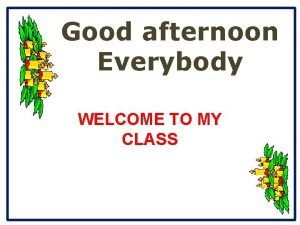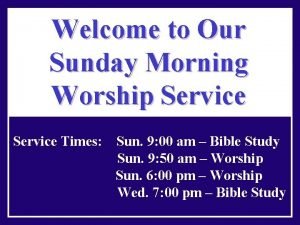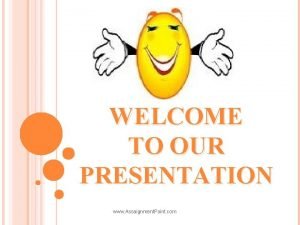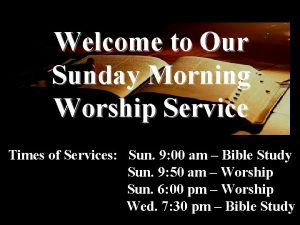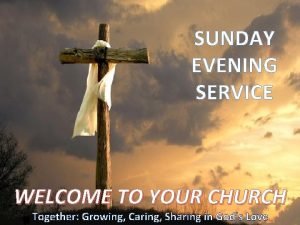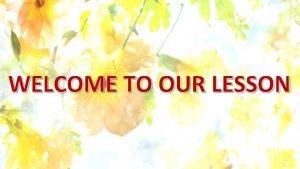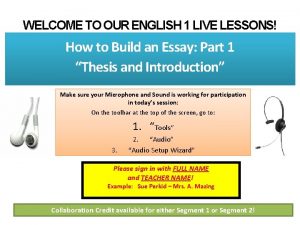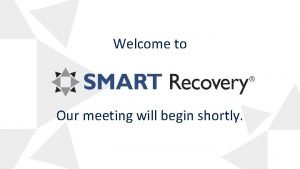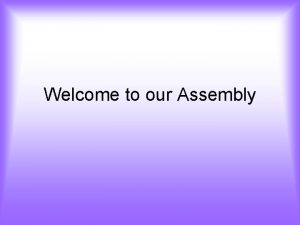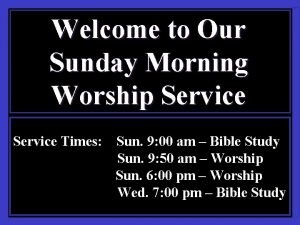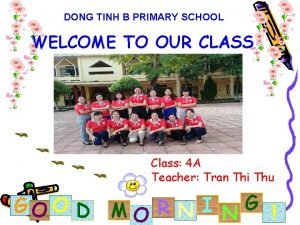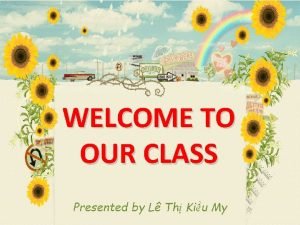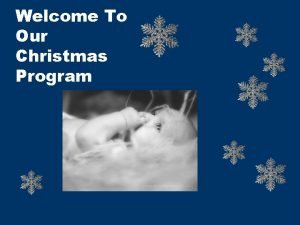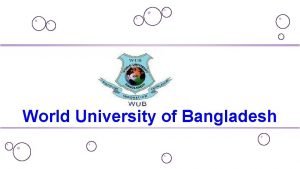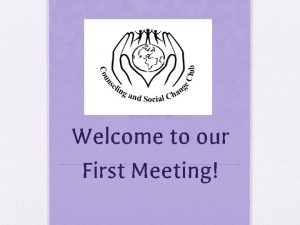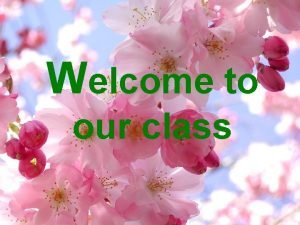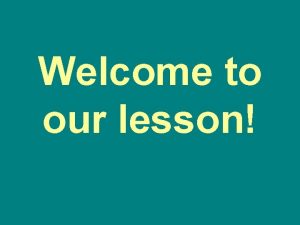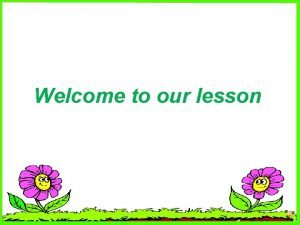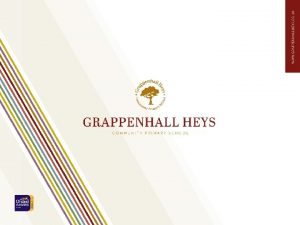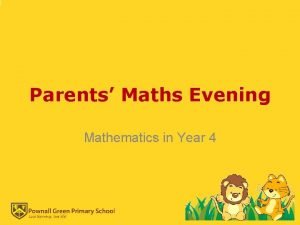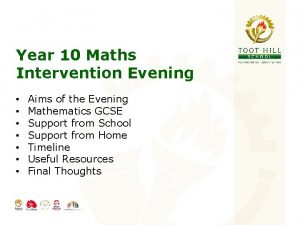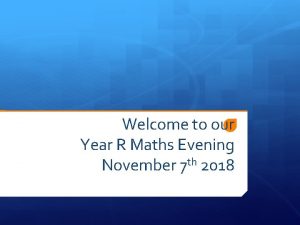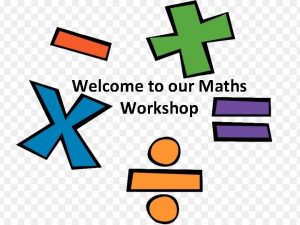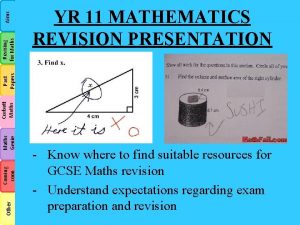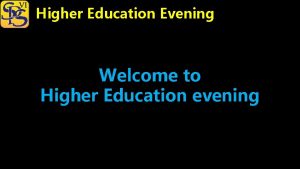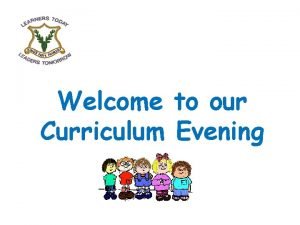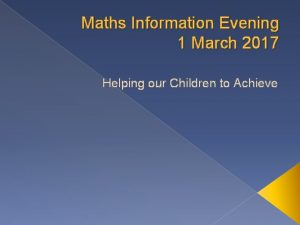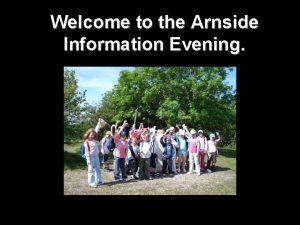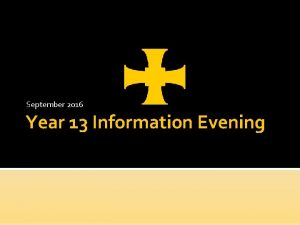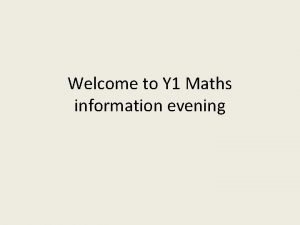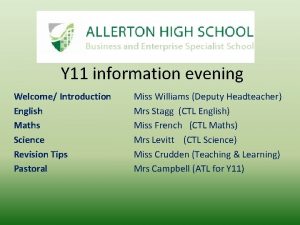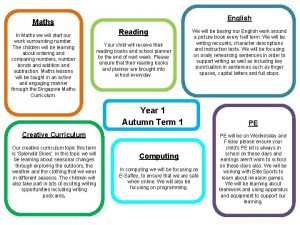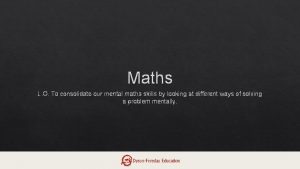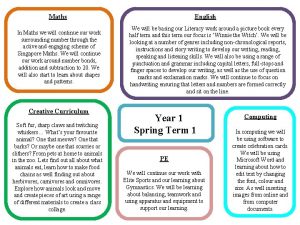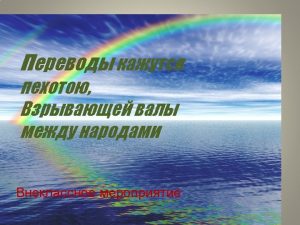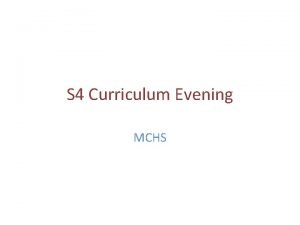Welcome to our Maths Evening Aims for this


























- Slides: 26

Welcome to our Maths Evening

Aims for this evening A reminder of the definition of ‘mastery’. Update on our approach to the new mathematics curriculum. Re-visit the end of year expectations for each year group. Ideas of how you can support your child.

The mastery curriculum Teachers reinforce an expectation that all pupils are capable of achieving high standards. The large majority of pupils progress through the curriculum content at the same pace. Differentiation is achieved by emphasizing deeper knowledge and through individual support and intervention. Practice and consolidation play a central role. Carefully designed variation within this builds fluency and understanding of underlying mathematical concepts in tandem. Teachers use precise questioning in class to test conceptual and procedural knowledge, and assess pupils regularly to identify those requiring intervention so that all pupils keep up.

What are the aims of the new curriculum for mathematics? Pupils should become fluent in the fundamentals of mathematics so that they develop conceptual understanding and the ability to recall and apply knowledge rapidly and accurately. Pupils should develop the ability to reason mathematically by following a line of enquiry, conjecturing relationships and generalisations, and developing an argument, justification or proof using mathematical language. Pupils should be able to solve problems by applying their mathematics to a variety of routine and non-routine problems with increasing sophistication, including breaking down problems into a series of simpler steps and persevering in seeking solutions.

How do we interpret these aims at Tavistock Infants? Using a mixture of whole class teaching, group and individual work to develop children’s recall and application of key facts and skills. Giving children the opportunity to enquire, reason, describe, represent, interpret and explain using mathematical language. Ensuring that all children experience a variety of practical and investigative problem-solving activities presented in meaningful contexts. Presenting maths as a creative and fascinating process in which children are encouraged to use their imagination, initiative and flexibility of mind.

What is our statutory guidance? For Year R we use “The Statutory Framework for the Early Years Foundation Stage – Setting the standards for learning, development and care for children from birth to five” (Df. E September 2014) For Key Stage 1, we use the relevant part of the September 2013 Df. E document “The National Curriculum in England – Key Stages 1 and 2 framework document” In the following slides, the red statements refer to Year R, the green statements refer to Year 1 and the purple ones refer to Year 2.

Numbers, Counting and Place Value Count reliably with numbers from 1 to 20, place them in order and say which number is one less or one more than a given number. Count to and across 100, forwards and backwards, beginning with 0 or 1, or from any given number. Count, read and write numbers to 100 in numerals; count in multiples of twos, fives and tens. Given a number, identify one more and one less. Identify and represent numbers using objects and pictorial representations including the number line, and use the language of: equal to, more than, less than (fewer), most, least. Read and write numbers from 1 to 20 in numerals and words.

Numbers, Counting and Place Value Count in steps of 2, 3, and 5 from 0, and in tens from any number, forward and backward. Recognize the place value of each digit in a two-digit number. Identify, represent and estimate numbers using different representations, including the number line. Compare and order numbers from 0 up to 100; use <, > and = signs. Read and write numbers to at least 100 in numerals and in words. Use place value and number facts to solve problems.

How to help with Numbers, Counting and Place Value Count objects at every opportunity, don’t just recite numbers. Practise different counting strategies, especially with traditional board games. Make amounts using 10 p and 1 p coins to support place value. Practise quick recall of number bonds to 10 and then to 20. Describe numbers accurately e. g. 12 is made of 10 and 2 so we write the 10 as the digit 1 and the 2 as the units/ones. Count in 10 s from any number, not just zero, as this will aid addition and subtraction on the unstructured number line.

Try this – what’s my secret number? My number is > 75 but < 100. It is not an odd number. It is a multiple of 5. It has an odd number of tens. The sum of its two digits is 9.

Addition and Subtraction Using quantities and objects, add and subtract two single digit numbers and count on or back to find the answers. Read, write and interpret mathematical statements involving addition (+), subtraction (–) and equals (=) signs. Represent and use number bonds and related subtraction facts within 20. Add and subtract one-digit and two-digit numbers to 20, including zero. Solve one-step problems that involve addition and subtraction, using concrete objects and pictorial representations, and missing number problems.

Addition and Subtraction Solve problems with addition and subtraction using concrete objects and pictorial representations, including those involving numbers, quantities and measures, and apply their increasing knowledge of mental and written methods. Recall and use addition and subtraction facts to 20 fluently, and derive and use related facts up to 100. Add and subtract numbers using concrete objects, pictorial representations, and mentally, including: a two-digit number and ones a two-digit number and tens two-digit numbers adding three one-digit numbers Show that addition of two numbers can be done in any order (commutative) and subtraction of one number from another cannot. Recognize and use the inverse relationship between addition and subtraction and use this to check calculations and solve missing number problems.

How to help with Addition and Subtraction Practise even quicker recall of number bonds to 10 and then to 20. Use these bonds to play missing numbers e. g. 23 + ? = 30 Play “True or False” with number facts. Talk about addition and subtraction in real-life contexts.

Multiplication and Division Solve problems including doubling, halving and sharing. Solve one step problems that involve multiplication and division, using objects, pictorial representations and arrays. Recall and use multiplication and division facts for the 2, 5 and 10 multiplication tables, including recognizing odd and even numbers. Calculate mathematical statements for multiplication and division within the multiplication tables and write them using the multiplication (×), division (÷) and equals (=) signs. Show that multiplication of two numbers can be done in any order and division of one number by another cannot. Solve problems involving multiplication and division, using materials, arrays, repeated addition, mental methods, and multiplication and division facts, including problems in contexts.

How to help with Multiplication and Division Practise number sequences for 2 s, 5 s and 10 s using a finger count as this helps with times tables later on. Count forwards and backwards to 100 in these sequences. Practise doubles of whole numbers and the related halves. Find real-life arrays and relate to multiplication facts e. g. egg boxes, cake tins, chocolate bars. Pose real problems e. g. planning food for a party Practise sharing out objects, with and without remainders.

Measures Using everyday language, talk about size, weight, capacity, position, distance, time and money to compare quantities and objects and to solve problems. Compare, describe and solve practical problems for length, height, weight, capacity and time; measure and begin to record length, height, weight, capacity and time. Recognize and know the value of different denominations of coins and notes. Sequence events in chronological order using language e. g. before and after, next, first, today, yesterday, tomorrow, morning, afternoon and evening. Recognize and use language relating to dates, including days of the week, weeks, months and years. Tell the time to the hour and half past the hour and draw the hands on a clock face to show these times.

Measures Choose and use appropriate standard units to estimate and measure length/height in any direction (m/cm); mass (kg/g); temperature (°C); capacity (litres/ml) to the nearest appropriate unit, using rulers, scales, thermometers and measuring vessels. Compare and order lengths, mass, volume/capacity and record the results using >, < and = Recognize and use symbols for pounds (£) and pence (p); combine amounts to make a particular value; find different combinations of coins that equal the same amounts of money. Solve simple problems in a practical context involving addition and subtraction of money of the same unit, including giving change. Compare and sequence intervals of time; know the number of minutes in an hour and the number of hours in a day. Tell and write the time to five minutes, including quarter past/to the hour and draw the hands on a clock face to show these times.

How to help with Measures Play with coins and sort them by size, colour, shape and value. Count forwards and backwards in 1 s, 2 s, 5 s and 10 s using coins. Make amounts in different ways e. g. 25 p with silver coins and then with copper coins. Support telling the time to the nearest 5 minutes. Encourage weighing, estimating, filling, pouring and sorting with ingredients and containers in the kitchen. Use calibrated scales e. g. measuring jug, thermometer

Fractions Solve problems including doubling, halving and sharing. Recognize, find and name a half as one of two equal parts of an object, shape or quantity and a quarter as one of four equal parts of an object, shape or quantity. Recognize, find, name and write fractions 1/3, 1/4, 2/4 and 3/4 of a length, shape, set of objects or quantity. Write simple fractions e. g. 1/2 of 6 = 3 and recognize the equivalence of 1/2 and 2/4.

How to help with Fractions Experience filling containers – empty, half full… Encourage dividing food in half – one cuts, the other chooses – to emphasize the need for identical portions. Find half by folding and then find a quarter by folding again. How many toys in your toy box? Take half out.

Shape Explore characteristics of everyday objects and shapes and use mathematical language to describe them. Recognize and name 2 -D and 3 -D shapes. Identify and describe the properties of 2 -D shapes, including the number of sides and line symmetry in a vertical line. Identify and describe the properties of 3 -D shapes, including the number of edges, vertices and faces. Identify 2 -D shapes on the surface of 3 -D shapes e. g. a circle on a cylinder and a triangle on a pyramid. Compare and sort common 2 -D and 3 -D shapes and everyday objects.

How to help with Shape Look for and identify shapes in the environment. Make and describe repeating patterns and play with symmetry. Encourage mathematical descriptions e. g. triangular, curved, and use the correct vocabulary to name and describe shapes

Position, Direction and Movement Recognize, create and describe patterns. Describe position, direction and movement including whole, half, quarter and three quarter turns. Order and arrange combinations of mathematical objects in patterns and sequences. Use mathematical vocabulary to describe position, direction and movement, including movement in a straight line and distinguishing between rotation as a turn and in terms of right angles for quarter, half and three-quarter turns (clockwise and anti-clockwise).

How to help with Position, Direction and Movement Use the language of position to describe where things should be placed at tidy up time. Make a simple Lego model and describe how to make it without showing it. Ask your child to describe where something is, encouraging the use of between, under, behind, in front of etc. Find a strategy for helping to remember left and right, clockwise and anti-clockwise.

Statistics Not mentioned in ELG for Maths. Not mentioned for Year 1. Interpret and construct pictograms, tally charts, block diagrams and simple tables. Ask and answer simple questions by counting the number of objects in each category and sorting the categories by quantity and by totalling and comparing categorical data.

How to help with Statistics Create opportunities for sorting and classifying toys. Ask questions about collections. Encourage explanations and justifications by putting things in the wrong category.
 Good afternoon everybody
Good afternoon everybody Wise men three clever are we
Wise men three clever are we Welcome to our worship service
Welcome to our worship service Welcome to our group presentation
Welcome to our group presentation Welcome to our presentation
Welcome to our presentation Our sunday morning
Our sunday morning Passover is in late march or early april
Passover is in late march or early april Welcome to our sunday service
Welcome to our sunday service Welcome to our class in chinese
Welcome to our class in chinese Welcome our class
Welcome our class Welcome to class 8
Welcome to class 8 Welcome to our first meeting
Welcome to our first meeting Welcome to the lesson
Welcome to the lesson Welcome to our english lesson
Welcome to our english lesson The meeting will begin shortly
The meeting will begin shortly Welcome to city guesser
Welcome to city guesser Welcome to our assembly
Welcome to our assembly Welcome to our meeting
Welcome to our meeting Our sunday morning
Our sunday morning Welcome to our class
Welcome to our class Welcome to our class gif
Welcome to our class gif Welcome to our christmas program
Welcome to our christmas program Welcome to our presentation
Welcome to our presentation Welcome to our first meeting
Welcome to our first meeting Welcome to our class
Welcome to our class Unscramble welcome
Unscramble welcome Welcome to our lesson
Welcome to our lesson
